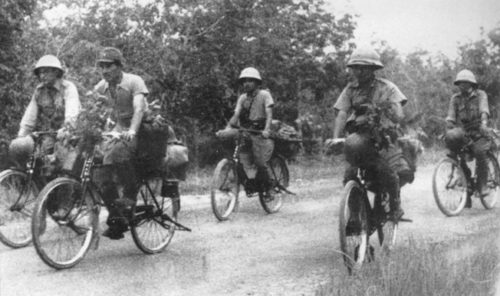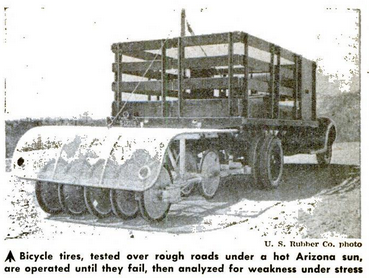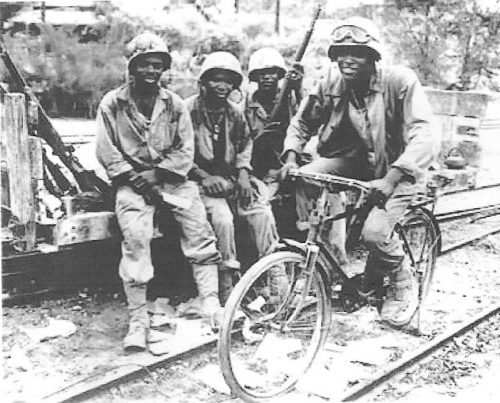
The February 1942 Battle of Singapore after the Malay campaign by the Japanese is perhaps the worst defeat of British arms in history. A core technology in the battle was the bicycle, used by Japanese troops in the jungle — despite having little to no prior relevant experience — to apply rapid and constant pressure in relentless pursuits of spooked defenders.
In retrospect it seems likely that if the British had been more scientific in Singaporean risk assessment (e.g. they blindly de-prioritized Malay strengh, bungled communications and lacked counter-intelligence), had the distracted British left in place any kind of competent resistance to over-confident and aggressive Japanese, then rapid assaults on Singapore might have failed.
Riding loud bike rims clustered together on confined paths into battle could instead have been a story about how it made the Japanese obvious and easy targets.
A blog post by Campfire Cycling makes a couple seemingly important psychological points about the swarm sound made by Japanese bicycles attacking at night.
The sound of a single squeaky chain, a rubbing brake pad, or a wheel rolling on the rims is bad enough. But by the dozens and the hundreds, they sounded to the beleaguered, undermanned British troops like the lightweight Japanese tanks. Time and again, Japanese bicycle infantry advanced past abandoned British defensive points. Broken-down bicycles were an unexpected psychological weapon.
This story telling is captivating. The squeaky chain definitely brings tanks to mind. Yet something else sounds slightly off in their narrative.
Set aside the fact the British had far more troops, so nobody should be calling them undermanned. Also set aside the fact that you need as few as three well-placed soldiers to eliminate a battalion on bikes. The other more nuanced errors are interesting.
Ok, just one important question about that fact before I let it go (for a minute). Wouldn’t someone realize the loud slow-moving upright clusters of bicycles on open roads made them trivial to anticipate and shoot like fish in a barrel?
Campfire Cycling analysis begs whether bikes were really intentionally broken-down or deconstructed into a louder and more resilient mode of operation and why? Was the effect of loud sounds planned, or an unexpected benefit later discovered by brash invaders?
Despite numeric superiority, the British troops were supposedly so spooked by the thought of tanks coming through the jungle that they withdrew apathetically and foolishly.
A quick check of 1920s records from the U.S. Bureau of Foreign and Domestic Commerce suggests bicycles predominantly used coaster brakes so that sound would have been familiar to defenders, for example.
All bicycles imported into the Netherlands Indies [Indonesia] have a coaster hub on the rear wheel without a braking device. […] Quotations are usually made for bicycles without tires.
Squeaky coaster brakes still could be ginned up to be some kind of “kiai” for the Japanese bicycles exported to countries they planned to invade, but there’s no evidence that squeaking brakes during attack helped them.
Chains… seriously if you can’t tell a street full of bicycle chain squeaks from light tanks, you probably don’t want to.
Likewise, official ledgers of bike imports from Japan say they came without tires, which hints at the opposite of loud rims being an “unexpected” noise. Dozens of tire-less bikes on roads in the dark was allegedly transposed into a belief tanks were coming out of the jungle, but again maybe those defenders didn’t really want to distinguish.
From the reverse perspective, were rolling metal bike rims among the sixty or seventy approaching troops evidence they believed a novel effect was created… to sound powerfully louder, larger or bold?
Element of surprise seems to be missing given small groups were bodily announcing themselves in a constrained and exposed position to attack “fortified” British.
As counter-intuitive as it sounds, it’s possible. Loudly pounding horse-shoes in a gallop and yelling “charge” brought unexpected psychological benefits during a mounted attack against heavily fortified defenses as I’ve written about here before.
A better and simpler explanation than advance planning for loud frontal assault is that Japanese Colonel Tsuji Masanobu, one of the Singapore Battle planners, had set in motion two infantry divisions equipped each with six thousand bicycles (as well as five hundred motor vehicles) to move quickly regardless of obstacles.
A violent racist and mass murderer, [Colonel Tsuji Masanobu] escaped prosecution as a war criminal with the help of American authorities and went on to work for the CIA. […] A CIA assessment judged him unreliable and ineffective.
Tsuji’s lies and arrogance served his campaign well as he stopped at nothing, throwing away the lives of his men. Tubes or not, loud metal rims or not… war crimes or not, he pressed forward. Resistance would likely have torn him to pieces. Thus among milquetoast and blind Bitish defenders lacking strategy other than withdrawing to leaky “strongholds” (compromised by Japanese informants) we can see more of why Tsuji’s reckless metal rim assaults worked.
The British sloppily sabotaged supply depots, roads and bridges in advance (instead of when bicycles were on them) to stop assault and the Japanese went through or around anyway because that’s what bicycles were known to do for decades before those roads and bridges existed. When conditions were blamed for flat tires, it was the impatient brutality of Japanese leadership that meant soldiers were expected to ride only rims.
Early battle upsets came as expected from Japanese intelligence aggressively targeting Indian Urdu-speaking troops being led by inexperienced British officers who only spoke English (experienced and competent ones had been rotated into defending the Middle-East).
I say expected because the Japanese leveraged an extensive “refined” network of informants on the ground. British weakness such as communication barriers was no secret. It’s hard to overstate in that sense just how thoroughly compromised British defensive positions were, especially given how susceptible British intelligence and communication lines were to murderous Japanese invaders who shifted local “support” (according to Tsuji).
When engaged in battle, the troops left their bicycles in the rear with a few soldiers on guard. As soon as the enemy began to retreat, our troops had to follow in close pursuit. The men guarding the bicycles would obtain cooperation of the Malay, Indian and Chinese residents of the locality to carry the bicycles forward to our advancing troops. Such bicycle transport units would be commanded by a Japanese soldier, not even understanding the languages of the mixture of races following him as he went forward carrying the Japanese flag at the head of his bicycle column. The men who trotted along the well paved roads, leading hundreds of silver wheels, were surely an army in the form of a cross for the emancipation of East Asia.
I want to highlight that such a weird pseudo-fascist perspective about achieving willing “cooperation” from locals (e.g. people being violently tortured and pressed into service) is the opposite of truth and a good example of Tsuji’s lies.
Japanese aggression in Southeast Asia was an extension of the Sino-Japanese War. Among Japanese military officers and men there was a culture of prejudice toward the Chinese and other Asian people. These attitudes had deepened following the Sino-Japanese War of 1894-95 and were embedded within the Japanese population as a whole by the 1930s. […] Clearly, then, the Singapore Massacre was not the conduct of a few evil people, but was consistent with approaches honed and applied in the course of a long period of Japanese aggression against China and subsequently applied to other Asian countries.
Back to the questions about planning for loud rims, Japan had allocated at least a couple mechanics to each company to repair flats. That does make it seem like they had intended to keep stealthy rubber rolling.
Yet obviously to an impatient liar like Tsuji the upsides ftom tire repairs (averaging dozens per day) were deemed less desirable versus driving forward on noisy metal before his strategic bluster could be unraveled. Brazen squeaky pursuit of a fast-withdrawing British line meant slowing down for repairs made no real sense.
The Malay peninsula was in fact defined by British laying down a paved road system that meant bicycles on the invading warpath didn’t need rubber to ride. The British had setup a veritable open back door into Singapore that may as well have included red carpet…. Far from being a heavily-fortified stronghold, weich the British thought they had engineered, the country was wide open to assault.
“Curiously enough, throughout all these years of bickering and indecision, it had occurred to barely anyone that Malay had over 1,000 miles of coastline, half of it exposed to Japanese attack,” writes author Arthur Swinson in Defeat in Malaya: Fall of Singapore. “It had occurred to no one either that the defence of the naval base on Singapore island was bound up with the defence of the whole Malayan Peninsula.” Or, as Churchill recalled, the possibility that the fortress would have no landward defenses “no more entered into my mind than that of a battleship being launched without a bottom.”
This sounds a lot like France thinking nobody would drive tanks through a forest, opening the door to invasion. Oops. It also sounds like the French believing hype and nonsense instead of immediately countering. A whole peninsula of roads near beaches not only helped the British in their retreat, but also facilitated the incoming attacks… on those noisy bike rims.
Here’s a slightly different telling from the 2015 book “The Fall of Malaya and Singapore” on page 73.
Because of Malaya’s intense heat, the bicycles’ tires blew out. However, the resourceful Japanese learned to ride down the paved motor road trunk on the rims of the bicycles. The sound of metal to pavement sounded like tanks and the peninsula’s defenders, notably the relatively inexperienced Indian troops who were terrified of armour, often broke for the rear.
Heat is blamed. Let me jump down this rabbit hope for a second.
Heat was certainly a known factor in local tire survival, especially given heavy loads (each Japanese soldier carried as much as 90 lbs) and of course distances traveled during the day or even night. There also may be some hidden history here if locals pressed into bike maintenance hid or sabotaged tires as a form of resistance to Japanese invasion. We have evidence of sympathizers and intelligence assets, yet not much research on the opposite.
Tire technology from before the war in any case was very unlikely designed to handle demands of any military campaign, as documented in postwar reporting.

So the rims were common, and were a known sound. Inexperienced soldiers lacking command who weren’t sure what tanks sounded like (there weren’t any tanks to defend and morale was linked to the false hope attackers couldn’t use them either) is probably the real key to this story.
All that being said about the psychological effects of bike rims on pavement, it was just one symptom among devastating morale events in Singapore.
Foremost was the pride of the British Navy expected to magically protect Singapore — battleship HMS Prince of Wales — quickly was disabled and then sunk by Japanese torpedoes. That turnabout alone opens a huge topic of British strategic technology planning and decline of naval strength; risks from overconfidence in large and slow “fortress” thinking versus the “101” of agile and irregular smaller forces.
I’m reminded here now of the Ukrainians recently sinking Russia’s flagship.
Aside from such naval mistakes, there’s also an important footnote that the British entirely missed the boat on keeping land armor ready.
Light-weight tanks landed and maneuvered by the Japanese through jungle beg a rather obvious question why Allied armor was missing in response, even though it could have been decisive. It certainly could have helped educate defenders to the real sound of tanks coming.
The British War Cabinet (believing tanks wouldn’t serve hills and jungle, let alone have the parts and crews to maintain them) transferred hundreds away from Malaya to Russia in a diplomatic lift that likely helped defend Moscow. If that sounds like France surprised when Nazis drove tanks around the Maginot line through the Forest of Ardennes, or Rome surprised when Hannibal Barca crossed the Alps for that matter… the British should have known better.
It was exactly this kind of a refocus to other parts of the world and belief in natural obstacles, opening a clear gap in exposed, mismanaged and inexperienced Singaporean defenders, that Japanese intelligence keyed on as the moment to roll.

For quick comparison to better prepared resistance, when a Japanese bicycle unit of about 300 moved on the Luzon Plain on Manila in December 1941 they were easily handled by defenders.
Filipino riflemen accompanied by American armor made quick work of Japanese cyclists as they attempted to ride into withering fire. Even as bikes scattered or turned to ride in retreat nearly all were eliminated.
Ironically the Japanese scattered propaganda leaflets to intimidate their targets from using the kind of tactics the Japanese had just been engaged in themselves.

A similar scene unfolded with Australian rifle fire from the far side of a bridge in Malay; Japanese rode up exposed and many were killed before turning their bicycles around to withdraw. At that point the Australians detonated the bridge killing the rest.

In other words the “tanks are coming” sounds generated by bicycle rims on asphalt at night is more accurately a reference to psychological warfare, exploring an imbalance of intelligence. Japanese propaganda about “unexpectedly” landed tanks for driving through jungle went unanswered…. It was outsized and uncontrolled fear of the possibilities of armor coming that thoroughly spooked unarmored defenders into falsely believing loud rim sounds alone were a reliable signal to withdraw.